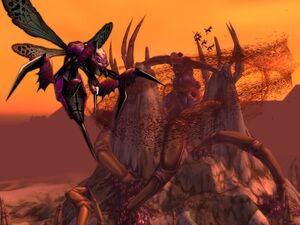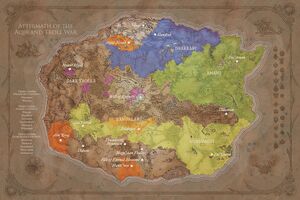Aqir and Troll War
| Aqir and Troll War | |||||||||||
|---|---|---|---|---|---|---|---|---|---|---|---|
 | |||||||||||
| Date | 16,000 BDP | ||||||||||
| Location | Kalimdor | ||||||||||
| Result |
Decisive troll victory
| ||||||||||
| |||||||||||
| |||||||||||
| |||||||||||
| Previous | First war between the earthen and the iron dwarves | ||||||||||
| Concurrent | Burning Crusade | ||||||||||
The Aqir and Troll War[2] was a major conflict between the aqiri empire of Azj'Aqir and the troll Empire of Zul that took place across large portions of ancient Kalimdor circa 16,000 BDP.[3][4][5] Thanks to the machinations of Xal'atath,[6] the C'Thrax Kith'ix, a powerful servant of the Old Gods, was reawakened by renegade trolls at the base of the Zandalar Mountains and rallied the long-hidden insectoid aqir to wipe out troll civilization. In response, the most powerful troll tribe, the Zandalari, united the other tribes into the Empire of Zul and pushed back the aqir from Zandalar before sending the most powerful tribes to hunt down aqiri colonies in the far corners of Kalimdor and kill Kith'ix. After centuries of fighting, the trolls destroyed the aqir empire and contained the insectoids in different ends of the continent, where they evolved into several new races: the nerubians of Azjol-Nerub in the north, the qiraji of Ahn'Qiraj in the southwest, and the mantid of Manti'vess in the south. The troll factions subsequently grew more insular and developed into different empires in their own right.[3]
History
Kith'ix and Azj'Aqir
Circa 16,000 BDP, troll civilization flourished in Kalimdor. The most powerful group, the Zandalar tribe, lived in the city of Zuldazar atop the Zandalar Mountains, while other tribes—most notably the Gurubashi, Amani, and Drakkari—laid claim to vast swaths of land across Kalimdor. Major conflicts were rare, since land was plentiful and the trolls were such fierce fighters that they preferred to resettle than risk costly wars. The only place forbidden by the tribes' priests and loa was a small mound of black stone at the base of the Zandalar Mountains.[3]
The sentient dagger Xal'atath guided the outcast Gurubashi witch doctor Zan'do and his followers to the mound, which they discovered was actually the body of Kith'ix, a C'Thraxxi general of the Old Gods who had fallen into hibernation after being wounded by Keeper Tyr millennia earlier. At Xal'atath's urging, Zan'do performed blood rituals to awaken Kith'ix,[6] who stirred to life and killed those who'd revived it. Kith'ix knew that it'd please the Old Gods to see the trolls' civilization annihilated and reached out with its mind for creatures it control. It discovered the aqir, insectoid servants of the Old Gods who had hidden underground since the fall of the Black Empire, and rallied them into retaking Azeroth's surface. While Kith'ix recovered, the aqir's ranks swelled and they constructed a vast subterranean empire, Azj'Aqir. When the time was right, Kith'ix led the insectoids to sweep across the land.[3]
Empire of Zul
Though the trolls were formidable foes, they had never faced anything like the aqir, and numerous smaller tribes were destroyed by the insectoids.[3] Kith'ix itself used Xal'atath's power to weaken the trolls with pestilence and dark visions, and even after the war many tribes would recount legends about the blade that had nearly driven them to extinction.[6] As the aqir approached the Zandalar Mountains, the Zandalari united the troll tribes into a single force, the Empire of Zul, to destroy the attackers. The Zandalari took on a commanding role from their strategic position in the mountains and guided the other tribes into whittling down the enemy's numbers with ambush tactics in the surrounding jungles. Meanwhile, troll priests summoned the loa, who fought alongside the trolls and managed to wound Kith'ix. The aqir were forced to retreat before they could besiege the mountains. Kith'ix fled northeast with its closest followers to recover while the rest of the aqir continued the war. The trolls had learned that it wasn't enough to kill the aqir, since they'd simply establish new colonies and rise up again if allowed to escape underground. To permanently end the threat, the Zandalari convinced the most ambitious tribes to create new strongholds across Azeroth, after which they could claim the new lands for themselves.[3]
The Drakkari tribe attacked an aqiri colony in the north, who had enslaved a group of tol'vir dwelling outside Ulduar and turned them into obsidian destroyers.[3][7] The destroyers nearly overpowered the Drakkari, but the tribe devised ways to topple and destroy the tol'vir. In the southwest, the Gurubashi tribe attacked a colony that had overrun the titan-forged complex of Ahn'Qiraj and enslaved its anubisath guards. Early engagements proved disastrous for the Gurubashi, as the aqir and their anubisaths destroyed several large Gurubashi encampments. At the Zandalari's instruction, the Gurubashi priests split their tribe into smaller raiding parties which could bleed the insectoids dry over many years, allowing them to eventually win control of the area. Meanwhile, the Amani tribe tracked Kith'ix far into the northeastern woodlands. They cut through an unending mass of aqir, and in a final battle, the entire tribe launched a suicidal attack on Kith'ix. Though only a tiny fraction of the Amani survived, they managed to kill the C'Thrax. For this, the Amani earned a legendary reputation among the other tribes. Atop the site where they'd killed their foe, they established a settlement that would one day grow into the city of Zul'Aman.[3]
With Kith'ix gone, the aqir no longer fought with as much ferocity, and the war shifted dramatically in the trolls' favor. After many centuries of fighting, the trolls shattered Azj'Aqir, permanently scouring central Kalimdor of the insectoids' presence and containing them in the far northern and southern corners of Kalimdor. The aqir fortified their underground settlements and showed no more interest in fighting, and the trolls proclaimed themselves the victors.[3]
Aftermath
Without the war to bind them together, the troll factions grew more insular, and the strongholds they'd built during the war developed into independent empires in their own right: the Drakkari Empire in the north, the Amani Empire in the northeast, and the Gurubashi Empire in the south. The Zandalari withdrew to their mountain plateaus to pursue spiritual knowledge, but retained a great deal of influence over the other tribes. Meanwhile, the aqir split into three distinct cultures of their own: the nerubians of Azjol-Nerub in the north, the qiraji of Ahn'Qiraj in the southwest, and the mantid of Manti'vess in the south (who had already split from Azj'Aqir before the empire's fall in the later stages of the war).[3] The rest of the original, unaltered aqir race was assumed to have been driven to extinction, but they in fact retreated underground to rebuild.[8]
Notes
- At some point during the war, the C'Thrax Mythrax was tasked with invading the jungle region of Vol'dun on Zandalar.[1] He slaughtered the region's Zandalari and sethrak inhabitants until he was defeated by the loa Sethraliss (who gave her own life in the process), though not before Mythrax was able to destroy one of the seals of Uldir inside Atul'Aman.[9]
- The History of Warcraft and Troll Compendium originally depicted the war as a more drawn-out conflict taking place over "thousands" of years (rather than centuries), and only involved the aqir and the Gurubashi and Amani empires, with no mention of involvement from the Zandalari or other tribes.[4][5]
References
- ^ a b The Lost Codex 2018-11-03. Blizzcon 2018 Interview: Alex Afrasiabi & Patrick Dawson - Story and Systems | The Lost Codex. YouTube. Retrieved on 2018-11-03.
- ^ File:Kalimdor Chronicle.jpg
- ^ a b c d e f g h i j World of Warcraft: Chronicle Volume 1, pg. 70 - 74
- ^ a b
 [The Twin Empires]
[The Twin Empires]
- ^ a b The Troll Compendium: Early Troll Civilization - The Rise of Troll Civilization
- ^ a b c Word of the Conclave: Xal'atath, Blade of the Black Empire
- ^ Ask CDev Answers - Round 1
- ^
 [50] A Bit of Investigation
[50] A Bit of Investigation
- ^
 [30-60] The Keepers' Keys
[30-60] The Keepers' Keys
es:Guerra entre los Aqir y los Trol pl:War between Aqir and Trolls

